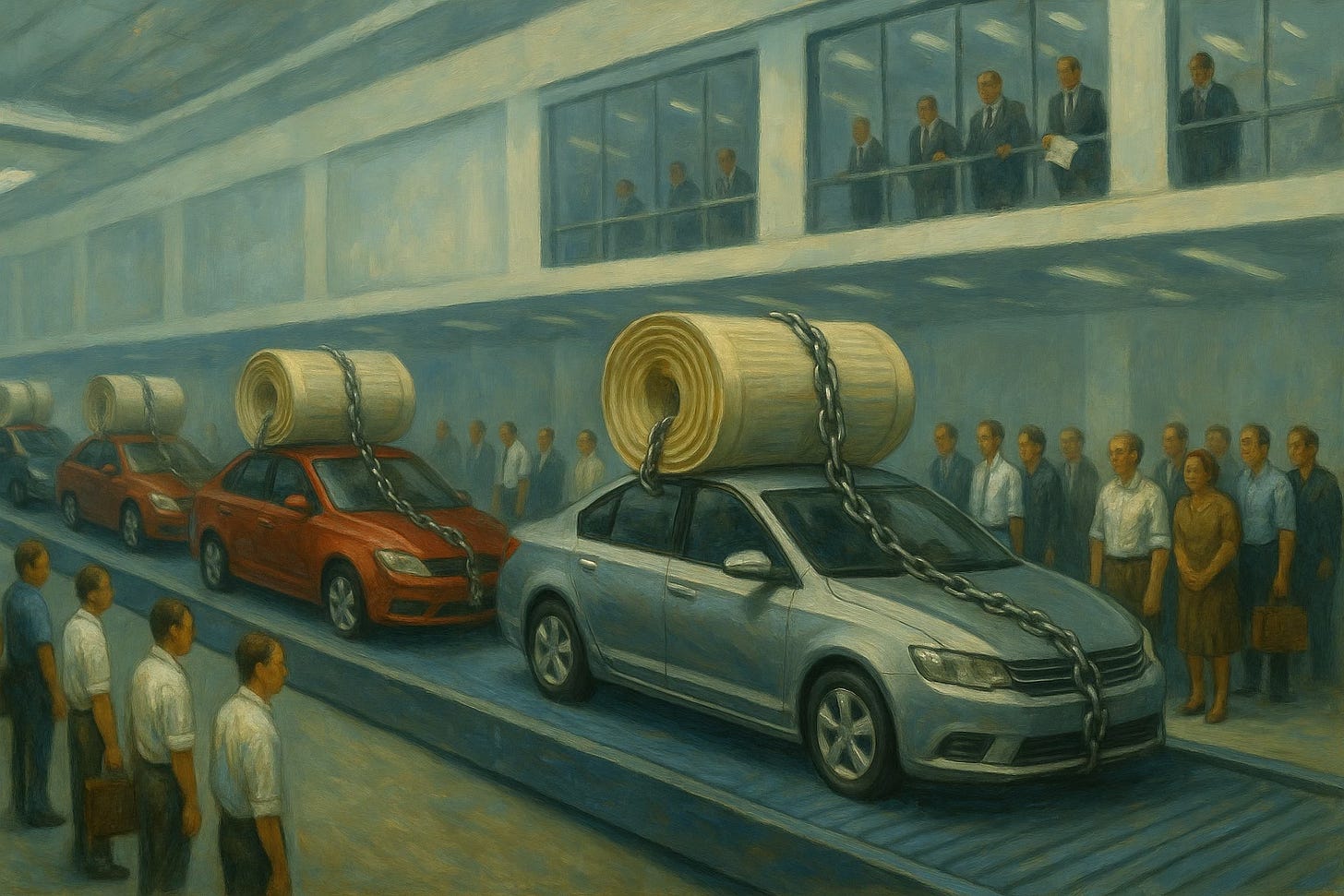The Death of the Five-Year Loan
Longer terms dominate the auto market in 2025.
The car isn't the product. The note is.
Stretch a $40,000 loan from 60 months to 84 and a $782 problem morphs into a $593 compromise. That single lever—term length—explains why seven-year auto loans grabbed 21.6% of financing in Q2 2025, while six-year notes climbed to 36.1%. Five years, the old standard, shrank to 19%.
And yes, some lenders are back to floating 96-month paper like 2008 never happened.
Average transaction price sprinted 28% over five years to almost $50,000. Dealers don't sell cars anymore. They sell time.
Average monthly payment hit $747 in mid-2025, a record. Stack that against median household income (~$70,000) and it collapses under mortgage, insurance, and groceries.
Seven-year financing adds roughly $4,600 more in interest than a five-year loan, but buyers swallow it because no car means no job in most of America.
Average loan: $41,400 in early 2025, with rates hovering around 7%. Five years at that math spits out $1,000+ a month. Stretch to 84, slip under $800. That's the difference between possible and impossible for a family budget.
You're not building equity. You're renting money to own a depreciating asset that loses 20% of its value the second it hits pavement.
Cars drop 20% at purchase, 60% in five years. With 84-month loans, you crawl through principal while the car's value nosedives.
Edmunds shows 26.6% of trade-ins in Q2 2025 underwater—average shortfall $6,754. One in four buyers rolls old debt into new paper, doubling down on the treadmill.
Delinquency rates ticked up: 5% of auto loans were 90+ days late in Q1 2025. That's the canary. When the next downturn hits, stretched notes won't bend, they'll snap.
The used market, once the pressure valve, isn't saving anyone. A 2018 with 50k miles listed at $22k next to a fresh 2023 at $24k? That's not choice. That's surrender.
Average used car: $30k now versus $18k in 2015. Pandemic-era production gaps plus dealer fair market value choreography turned secondhand shopping into theater.
Private sales on Facebook Marketplace still offer deals, but most buyers default to dealer lots where markup is standard operating procedure.
Mike Schwartz—ex Ford Credit—watches 96-month loans creep back and shakes his head. Less than 1% now, but rising. He remembers 2008. Bank presidents swore never again.
Dealers ride the split incentive. Long terms move iron and sell trims, but customers sit on cars longer, choking trade-in flow. Underwater buyers aren't just bad for households—they clog dealer pipelines too.
Banks package auto loans into securities and spray the risk across the system. As long as someone else holds the bag, there's no reason to tighten standards.
Fleet age tells the rest: 12.6 years on average now, versus 5–6 in the 70s and 80s. Cars last longer, but buyers keep them longer because costs outpaced wages. Industry's answer? Stretch payments, not lower prices.
Technology bloat crushes affordability twice: at purchase and repair. A basic windshield swap used to be $500. Add cameras and calibration, now it's $1,000+. Infotainment stacks and driver assistance fluff that mostly assists the finance office.
Manufacturers killed cheap models. No Fit, no Yaris, no Focus. Buyers funneled into tall hatchbacks playing SUV. A 2005 base Camry cost $18,195 ($30k adjusted). Today's base Camry lists at $28,500, but good luck finding one without $5,000 in confidence packages.
Safety regs push costs too, but manufacturers milk compliance to kill low-margin trims outright.
AWD in Atlanta for one snow day every three years. Suburban families financing six-thousand-pound pickups to haul groceries. The gap between need and want is thousands in wasted financing.
Leasing works in narrow lanes: higher monthly, but no negative equity, no post-warranty repair risk, clean exit at three years.
Credit unions beat dealer math: 60-month terms, lower rates, focus on total cost not monthly theater. Pre-approval before stepping on the lot flips the entire script.
Used market strategy: private-party first, inspection mandatory, avoid early ADAS if you can't stomach $1,000 calibration bills. Maintenance records trump leather seats.
Nuclear option: pay cash for a ten-year-old sedan at $8,000. Tires, fluids, basic insurance. Zero payments. Minimal complexity.
Modern cars running 200,000+ miles mean higher stickers spread over longer lifespans can pencil out. But that assumes steady jobs, no big repairs, and a decade of tolerance for the same ride. Real life rarely plays that smooth.
Car dependency, wage stagnation, and loose lending standards converge. When you need a car to earn a living, the market charges whatever the financing system will bear. Stretch the loan, stretch the risk.
Median household income climbed less than 5% since 1995 while car prices ballooned 200–300%. Productivity gains went up the ladder. Everyone else finances time to afford depreciation.
Entry-level models gone. Carpool apps dead. Transit stuck in the 1970s.
When the next downturn hits, the auto loan market will crater. Buyers locked into seven-year notes on cars worth half their loan balance will default en masse. Dealers will act surprised. Lenders will point fingers.
Stop financing time. Buy the car.


